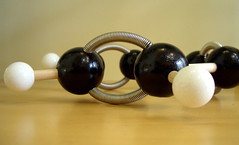Bonding and Reactions
Terms : Hide Images [1]
| the combining of atoms to form molecules or ionic compounds | ||
| the force that holds two atoms together. | ||
| the number of protons in the nucleus of an atom | ||
| electrons on the outermost energy level of an atom | ||
| a chemical bond in which one atom loses an electron to form a positive ion and the other atom gains an electron to form a negative ion | ||
| electrically charged atoms that have gained or lost electrons. | ||
| the regular pattern in which a crystal is arranged |  | |
| a chemical bond that involves sharing a pair of electrons between atoms in a molecule |  | |
| two or more atoms held together by covalent bonds |  | |
| a molecule consisting of two atoms | ||
| a bond formed by the attraction between positively charged metal ions and the electrons around them | ||
| the ability of a substance to be pulled into a wire | ||
| the ability of a substance to be hammered or beaten into thin sheets | ||
| the process by which one or more substances change to produce one or more different substances |  | |
| A solid that forms and settles out of a liquid mixture |  | |
| a chemical reaction in which heat is released to the surroundings |  | |
| A reaction in which energy is absorbed | ||
| the law that states that energy cannot be created or destroyed but can be changed from one form to another | ||
| a combination of chemical symbols and numbers to represent a substance | ||
| a small letter or number written below and to the right of a chemical symbol | ||
| a representation of a chemical reaction that uses symbols to show the relationship between the reactants and the products | ||
| the starting materials in a chemical reaction | ||
| the substances that are formed by the chemical change | ||
| the law that states that mass cannot be created or destroyed in ordinary chemical and physical changes | ||
| A number in front of a chemical formula in an equation that indicates how many molecules or atoms of each reactant and product are involved in a reaction. |
